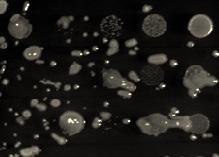
Photo Credits: Siddharth Kankaria/ Research Matters
Many organisms, including yeast, obtain Carbon and energy from carbohydrates and Nitrogen from other nutrients like amino acids. But some types of yeast, like Pichia pastoris, can use amino acids not only as sources of Nitrogen, but also as sources of Carbon too finds a new study at the Indian Institute of Science, Bangalore. The team, consisting of Mr. Umakant Sahu and Prof. P N Rangarajan from the Department of Biochemistry, have studied the mechanism behind how P. pastoris can grow happily in a medium that does not contain glucose but only amino acids like glutamate, aspartate, proline, etc.
Enzymes are biological catalysts that act on complex compounds and break them down into simpler molecules. They act on the food we eat and help break it down to simple molecules that our body can absorb and obtain the nutrition in the food. The enzymes are manufactured using the information coded in our genes. The genes that produce the enzymes are switched on or off as and when a nutrient becomes available in the medium. These switching on and offs of the genes are brought about by proteins called transcription factors in a process called “gene regulation”.
The researchers observed that the wild strain of yeast P. pastoris could grow in a glucose deficient medium containing only amino acids, whereas a mutant strain with a mutated gene that could not produce a protein Mxr1p, could not. This led them to believe that the protein Mxr1p was necessary to convert amino acids into Carbon and Nitrogen, acting as a transcription factor in P. pastoris. It was also found that Mxr1p acts as a key regulator for various genes like glutamate dehydrogenase, aspartate aminotransferases, malate dehydrogenase and glutamine synthetase, all of which are involved in the utilization of amino acids as sole source of carbon.
Another interesting observation of the study was the regulation of some of the above genes in the “post transcriptional level”. Most genes are regulated, or switched on, in the initial stages of transcription where mRNAs are produced. But in some cases, genes can be regulated at a later stage during translation where proteins are produced from these mRNAs. The researchers found that Mxr1p regulated glutamate dehydrogenase (GDH2) after transcription. The GDH2 mRNA levels in both wild type strain of P.pastoris and the mutant strain without the protein Mxr1p grown in the same medium were high and comparable. But the levels of the regulator protein gdh2p in these mRNAs were low in the mutant strain. This shows that Mxr1p protein must be regulating the expression of GDH2 gene after the mRNAs were transcribed and before they were translated.
Pichia pastorisis widely used as a host cell for the production of proteins since it grows to a very high density giving a good yield of proteins. Amino acids are routinely added to the growth medium along with other conventional Carbon sources as they enhance growth rate and recombinant protein production in which amino acids primarily serve as precursors for the synthesis of proteins. More studies based on these results may provide new insights into potential interactions between metabolism and amino acid metabolism on recombinant protein production, which may lead to novel biotechnological applications.
























